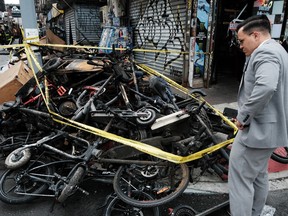
A recent e-bike battery fire on Toronto’s subway garnered both attention and expressions of concern about such lithium-ion batteries (Li-ion). Police, fire and Toronto Transit Commission officials expressed concern about electric bikes and their batteries.
Fires caused by high-energy Li-ion batteries spread rapidly and, because of chemicals involved, can be difficult to extinguish.
Advertisement 2
THIS CONTENT IS RESERVED FOR SUBSCRIBERS ONLY
Subscribe now to read the latest news in your city and across Canada.
- Unlimited online access to articles from across Canada with one account.
- Get exclusive access to the Windsor Star ePaper, an electronic replica of the print edition that you can share, download and comment on.
- Enjoy insights and behind-the-scenes analysis from our award-winning journalists.
- Support local journalists and the next generation of journalists.
- Daily puzzles including the New York Times Crossword.
SUBSCRIBE TO UNLOCK MORE ARTICLES
Subscribe now to read the latest news in your city and across Canada.
- Unlimited online access to articles from across Canada with one account.
- Get exclusive access to the Windsor Star ePaper, an electronic replica of the print edition that you can share, download and comment on.
- Enjoy insights and behind-the-scenes analysis from our award-winning journalists.
- Support local journalists and the next generation of journalists.
- Daily puzzles including the New York Times Crossword.
REGISTER TO UNLOCK MORE ARTICLES
Create an account or sign in to continue with your reading experience.
- Access articles from across Canada with one account.
- Share your thoughts and join the conversation in the comments.
- Enjoy additional articles per month.
- Get email updates from your favourite authors.
Article content
Article content
According to certified pyro-technician Kevin Cosgrove of Windsor, Li-ion fires can be closely related to the burning of fireworks which also are chemical or non-organic based fires. As such, they are much less susceptible to quenching by water than are organic based fires such as burning wood.
Cosgrove points out that with non-organic fires, attempting to use water to extinguish the fire instead ends up displacing the oxygen that feeds fires. In practice, water does not mix or “enter into” the fire’s fuel supply in the same way that organic fuels absorb water, thereby stemming a fire.
Consequently, water does not have the same impact combating combustion in chemical fires.
For Li-ion battery-powered micro-mobility products, water is an insufficient fire suppressant. Lithium-ion battery fires are especially dangerous because they burn fiercely and can release toxic gases with the risk of vapour cloud explosions.
Of course, when a fire spreads, as it did on Toronto’s subway car, other fire suppressant factors need to come into play.
There have certainly been plenty of recorded Li-ion battery fires and certainly some deaths. New York City’s fire commissioner recorded over 100 Li-ion battery fires in that city in 2023, resulting in 13 deaths.
Advertisement 3
Article content
Many such fires may be a consequence of over-charging and poor quality battery manufacture. Indeed, governments do not appear to have kept regulatory pace with the evolving technology.
Hence, limited regulation covering Li-ion batteries may have resulted in lower-quality products on the market, thereby increasing fire risk from charging devices such as those connected to e-bikes.
Last August, General Motors announced a recall of 142,000 Chevy Bolts — every Bolt ever made — because of fire risk to those electric cars.
Over 17 months, GM confirmed 13 fire incidents involving the model. GM attributed fires to a rare manufacturing defect by South Korea-based battery supplier LG Corp.
Technologically, things may change in the future as governments continue to announce financial support for electric vehicle and battery component factories. Already, alternate battery components are being seriously investigated and produced.
Lithium batteries with layered-oxide cathodes are expensive. They require cobalt and nickel which, like lithium, are rare minerals and hence expensive. There is an alternative and less expensive battery being developed which uses lithium-iron phosphate, but resulting batteries are less efficient storing energy when compared to current lithium layered-oxide batteries.
Advertisement 4
Article content
In the world of economics there’s a concept where marginal benefits exceed marginal costs. Thus, when the benefits of a technological change exceed the costs associated with research and development, a new product may emerge.
This appears to be happening with next-generation batteries. Batteries for vehicles and some consumer products fall within the general scope of where research may fundamentally alter the types of batteries and composition we will utilize in future.
Chemists are already exploring alternatives to lithium layered-oxide batteries in the form of sodium to replace lithium. Sodium-ion (Na-ion) batteries are already under development and production in China.
UK-based Benchmark Mineral Intelligence (aka Benchmark Minerals) is a specialist information provider for lithium-ion batteries to the electric vehicle supply chain industry. Benchmark data support those developing contracts for rare minerals, such as cobalt, graphite and nickel.
Benchmark identifies 36 Chinese companies either making or researching sodium batteries. Among these is Contemporary Amperex Technology Co. Limited CATL, headquartered in the city of Ningde in China’s Fujian province.
Advertisement 5
Article content
CATL has established thirteen battery manufacturing bases worldwide, mainly in China but also Germany and Hungary.
So, before both governments, media and the public respond to potential Li-ion batteries prospectively setting the world on fire bear in mind that technology is making headway on alternative battery compositions which may prove less fire-prone.
There is additional research pursuing even more alternatives. As often as not, governments as regulators of standards are invariably critically behind as technology rapidly leaps forward.
Windsor’s pending e-vehicle products may in the long run contain batteries less dangerous and, perhaps, just as reliable as current Li-ion batteries.
Lloyd Brown-John is a University of Windsor professor emeritus of political science. He can be reached at [email protected].
Article content

